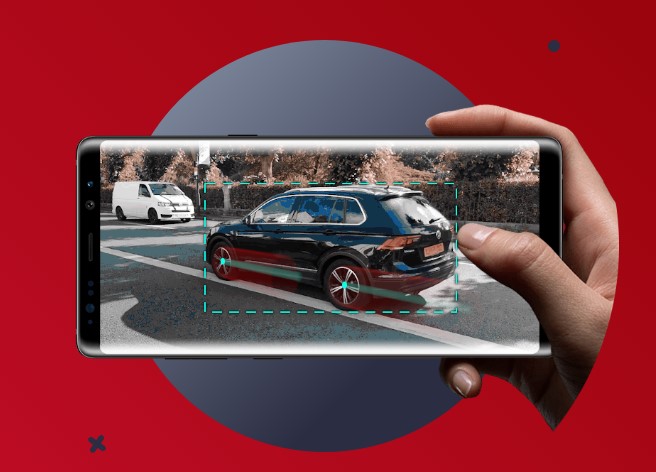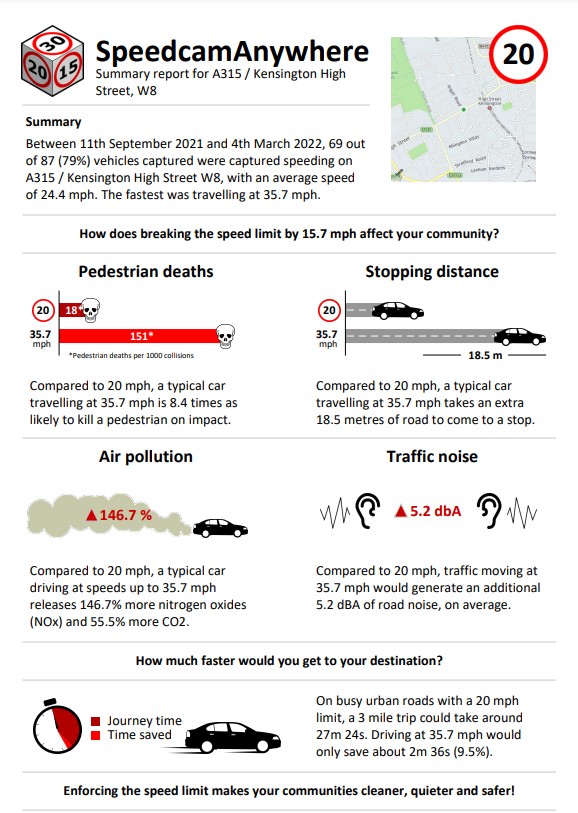
Speedcam Anywhere will be the first of a new wave of citizen monitoring apps
“Putting the power of AI in your hands to help make our roads safer and our air cleaner” says the website of Speedcam Anywhere.
So let’s take a look at what Speedcam Anywhere is and how it works.
Cars exceeding the speed limit has long been a contentious issue. Excess speed is certainly a factor in the road toll and it’s relatively easy to enforce as it’s a binary, either you’re over the limit of you’re not. Speeding fines are a income earner; in my home state of Victoria in Australia speeding fines earn the government around $319 million per year from around 6.9m citizens. That’s a lot of money but only a small percentage of the annual Victorian budget expenditure which is around $90 billion, and government figures estimate road trauma costs Victoria around $3-4 billion per year.
Yet speeding is hardly the only road safety problem, or even perhaps the most important. There’s two problems with a focus on speed alone; first, any speed beyond walking pace represents a risk so arguably speed contributes to every road traffic incident (we don’t use the term accident any more). As a society we make a tradeoff between time taken to get to our destination and safety; this leads to a ‘safe’ speed; walking pace for cars is silly, as is driving everywhere on the limit of traction like you’re on a racetrack so there’s a middle ground to be found.
Second, the speed limit is fixed regardless of the road conditions, weather, driver, car, traffic and everything else – all of which play a huge part in the ‘safe’ speed. There is no easy way to implement variable speed limits according to weather or conditions, and any such attempt to change the limit based on car/driver would be too problematic to even consider. So we have fixed limits, like it or not, at least for the moment. Self-driving cars will eliminate fixed speed limits in the future.
What is Speedcam Anywhere?
Now there’s an app for UK citizens, Speedcam Anywhere, which allows anyone to point their phone at a car and the app will quite accurately estimate the speed of the car.
How does Speedcam Anywhere work?
You hold your phone still, start the app, and the car in question drives by. The app reads the license plate, and looks up the details in a UK national database, possibly more than one.
Now the app knows what car it is. The app can then look up the wheelbase of the car (distance between centre of front and centre of rear wheels). In Australia RedBook have a lookup for apps which returns all sorts of vehicle details, once you’ve figured out which vehicle it is.
The app then calculates the speed of the car; it looks at when the front wheels pass a given point, to the thousandth of a second, and then when the rear wheels pass – and if it knows the wheelbase, it’s then easy to calculate the speed which is stated to be accurate to +/- 2mph, or 3.2km/h. Here’s a sample report:

I’m guessing the wheelbase is used because wheels are quite clear to the camera, and aftermarket modifications or vehicle damage don’t generally change the wheelbase. The developers say the app doesn’t work on HGVs (heavy goods vehicles) so I suspect it has a problem with vehicles that have more than 3 axles, but that would just be a matter of extra software development.
Is Speedcam Anywhere accurate?
There are many factors which would affect accuracy; whether the camera was moved during data capture, if the car was accelerating or declerating, whether the wheels are turned which slightly affects the wheelbase picture, and of course picture quality. All of these are quite small and can be mitigated to some extent or other by computation, which I guess is why the system uses AI (artificial intelligence), and delivers the accuracy it does. It is also possible to mis-read numberplates, and for the databases to have the wrong information entered.
The app isn’t perfect, as nothing ever is. Lots of factors mean the app can’t work, for example it needs 2 seconds worth of data, to read the license plate, and of course reasonable lighting. It works from around 15-20m away from the car, and whilst the website doesn’t say, I would imagine very high speeds would be problematic as there wouldn’t be many frames captured and those that are may be blurred. It seems to be designed for suburban speeds. However, the app knows its limitations and provides a response according to what it can determine. It certainly seems to be accurate, and the technology is there to make it possible.
Why does Speedcam Anywhere work only in the UK?
I guess that Speedcam Anywhere works only in the UK as for each country the app would need customising for a different registration database and a different vehicle details database where it could find the wheelbase. The developers are looking a the US market, and my guess is they could easily make it work in Australia as we have the necessary data lookups, as do most countries.
Why was Speedcam Anywhere developed?
From their website:
Putting the power of AI in your hands to help make our roads safer and our air cleaner.
The logic seems to be; use this tool to check speeds of any car you like, and then do something with the data to make them slow down, which will improve road safety and reduce pollution.
Whether this tool actually advances those noble aims is a matter of opinion.
So what does a user do once they’ve caught a vehicle speeding?
That’s up to the user. The data is not admissible in court in the same way as an official speeding camera; anyone who has contested a speeding fine knows how tightly the speedcam data is regulated, and some rando with an app isn’t going to pass the data integrity laws. However…I would imagine, and I’m no lawyer, that turning up with such evidence couldn’t do anything but help the case against a speedster, in the same way as dashcam data which is already used by authorities. It would be easy enough to independently verify the speed as recorded by the app; you’d just basically do what the app does and compare frame-by-frame vs car position against known objects to estimate accurately.
I guess if there was a complete idiot doing 100km/h in a 50km/h zone the app could be used to record that and the footage shown to the police, but to be honest you don’t need the app for that, just a video will do.
Here’s the rest of the report. I suppose app users wander up a start an conversation with it? That would go very well, I’m sure.

People who passionately believe in anything tend to believe that those who do not are simply ignorant and just need to be Shown The Light to see the error of their ways, and then, hey presto, they’ll believe too. I’m really not sure humans work that way though.
What’s the emissions angle?
The point they make is:
Vehicle exhaust emissions – CO2, PM2.5 and NOx – are highest during acceleration. Microplastic particulates from tire emissions are highest during braking, accelerating and cornering quickly. In urban areas, vehicles accelerate and decelerate repeatedly due to junctions and traffic. Allowing for the emissions when vehicles are accelerating and they typically have the lowest NOx and CO2 emissions, and the best mpg, when driven at maximum speeds of 15-20mph. Particulate Matter (PM2.5) from tyre wear and brake pad wear is a lot higher when decelerating from higher speeds, and also from cornering at higher speeds. Because of the extra emissions during acceleration, NOx and CO2 go up rapidly when driving at higher speeds in urban areas.
https://speedcamanywhere.com/#faq
This is over simplified, as is usually the case with environmentalists and cars. Firstly, the most efficent speed for a car is around 70-80km/h in cruise (here, here and here). Now that’s not possible with suburban driving, but that point isn’t really made in the text above, and it may well be better to accelerate gently to 60 for a 2 minute cruise than stick at 40km/h. There’s also impeding other traffic to consider; no point you reducing your emissions by 10% or whatever if you’ve caused three other cars to go up by 5% and for good measure a crash as well. This is why hypermiling can be dangerous, there’s a balance between economy driving and safety.
Secondly, they should consult the UK’s excellent IAM who would explain to them it’s not about speed per se, economy is about avoiding change of speed. So for example, let’s say we have a car doing 50km/h which brakes hard to a stop for lights, then accelerates quickly back to 50. And we have another car doing 60km/h, but with a more skilled driver who uses their powers of observation, notices the light will go red, backs off the accelerator to 40km/h – no brakes used – and cruises through the traffic lights, gently accelerating. That second car will be travelling faster but use less fuel, tyre wear, and brakes, and it’s travelling closer to the most efficient speed of say 70km/h. It’s disappointing to see a narrow focus on speed alone without any nuance.
Frankly, I think the effort spent on this app should have been spent on driver training and education. I say that as having passed my IAM test many year ago and I think such training should be mandatory for all drivers. We’d be safer and create fewer emissions as a result.
Is Speedcam Anywhere’s data secure?
From their FAQ:
The Speedcam Anywhere app digitally signs all data sent including video captures, timestamps and locations using industry standard SHA-256 algorithms. This ensures that the video has not been edited or manipulated. All data is transmitted using TLS 3.0 and secured on commercial secure cloud services using class leading security systems.
Well, lol. Hope you’re impressed by that, because nobody in the IT security industry would be. The SHA-256 standard is indeed industry best-practice, but there’s nothing in there about how it’s implemented; good tools can be poorly used. As for TLS (current version is 1.3 not 3.0), well every website has that these days so while that’s great security it’s really the minimum expected, and “commercial secure cloud services” – the cloud provider isn’t responsible for the security of what’s run on their systems, and again even if “class leading security systems” are bought, it’s all about how they’re used.
A more impressive answer would be to hire two or three reputable and well-known independent security teams and then publish a summary of the results; eg “XYZ Company and ABC Company have conducted a thorough audit of our systems and attempted to break them and failed etc etc”. And, “here is our privacy policy”…I couldn’t see a link to any such policy on their website. Kind of important, I’d have thought.
What else could be done with this technology?
In 2022, we’re really just at the beginning of what can be done to identify people and what they do. So here’s a potential next step for Speedcam Anywhere and to be clear, this is my speculation not their confirmed business plan.
The app has the license plate and vehicle details. Upload that, and then cross-reference other uploads of the same car. Then you can build a pattern, including predicting movement. You can also search for the rego, or car image itself on Google and see where else it’s been captured, gaining more information. If you have a clear shot of the driver’s face, then use ClearView AI to search for that person’s image, and maybe it’ll pop up on Facebook, LinkedIn or whatever else. Then you know who is driving the car, when, and where.
The scenario above is possible right now. Here’s how ClearView AI works:
…Clearview AI, devised a groundbreaking facial recognition app. You take a picture of a person, upload it and get to see public photos of that person, along with links to where those photos appeared. The system — whose backbone is a database of more than three billion images that Clearview claims to have scraped from Facebook, YouTube, Venmo and millions of other websites — goes far beyond anything ever constructed by the United States government or Silicon Valley giants.
https://www.nytimes.com/2020/01/18/technology/clearview-privacy-facial-recognition.html
The day isn’t far off when you can point a camera at someone, and then bring up a consoldiated summary of their digital life which today, is their life.
But without public scrutiny, more than 600 law enforcement agencies have started using Clearview in the past year, according to the company, which declined to provide a list. The computer code underlying its app, analyzed by The New York Times, includes programming language to pair it with augmented-reality glasses; users would potentially be able to identify every person they saw. The tool could identify activists at a protest or an attractive stranger on the subway, revealing not just their names but where they lived, what they did and whom they knew.
https://www.nytimes.com/2020/01/18/technology/clearview-privacy-facial-recognition.html
You can imagine for yourself the possibilities.
So what now?
We can’t un-invent technology, and if you read history you’ll see that every time there’s a technological advance – be that writing, telephone, email, instant-messaging or Internet access – there has been fear and concerns the world will change for the worse. Maybe it has, maybe it hasn’t…but one thing is certain, humans adapt to the new normal. You don’t miss what you never knew, and the babies born today will grow up in a world of very little privacy compared to their grandparents or even parents.
However, I do feel that we are at the beginning of a new era of interconnectedness and lack of privacy. I don’t have a solution, as I don’t even fully comprehend the opportunities and problems. But let’s start a discussion anyway because there are important issues to work through, now and even more so for tomorrow.
Videos
These aren’t related to Speedcam AI, but they are about EVs which is at least future tech related!



1 Comment
by DC
Robert I agree that, “People who passionately believe in anything tend to believe that those who do not are simply ignorant and just need to be Shown The Light to see the error of their ways, and then, hey presto, they’ll believe too. I’m really not sure humans work that way though.”
But you fall into this trap yourself when you say, “Frankly, I think the effort spent on this app should have been spent on driver training and education. ”
Not sure what the answer is, something to do with carrots and sticks for sure 😉
I look forward to this app coming to Australia.